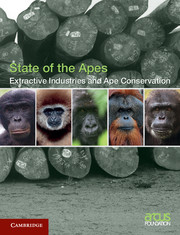Book contents
- Frontmatter
- Foreword
- Contents
- The Arcus Foundation
- Notes to readers
- Acknowledgments
- Photo
- Introduction
- Section 1
- Section 2
- 9 The status of apes across Africa and Asia
- 10 Status of captive apes across Africa and Asia: the impact of extractive industry
- Annexes
- Acronyms and abbreviations
- Glossary
- References
- Index
9 - The status of apes across Africa and Asia
Published online by Cambridge University Press: 05 June 2014
- Frontmatter
- Foreword
- Contents
- The Arcus Foundation
- Notes to readers
- Acknowledgments
- Photo
- Introduction
- Section 1
- Section 2
- 9 The status of apes across Africa and Asia
- 10 Status of captive apes across Africa and Asia: the impact of extractive industry
- Annexes
- Acronyms and abbreviations
- Glossary
- References
- Index
Summary
Introduction
This chapter provides information on the conservation and welfare of great apes and gibbons. It focuses on the distribution and environmental conditions in which apes live in both Africa and Asia. The information presented is drawn from various sources, especially from the A.P.E.S. Portal (http://apesportal.eva.mpg.de), and can be used by decision-makers and stakeholders to contribute to the development of informed policies and effective planning. Although reference is made to particular great ape and gibbon taxa in some parts of the report, discussions are tailored to address issues about apes in general (not necessarily species specific). Because data quality and availability are not uniform across all ape taxa, regions, or even countries, we refer to specific cases for which data are available and reliable. The current chapter has not yet been expanded to fully include the gibbons and, as such, data mining for this family is still limited; however, additional data collection will occur in between this and the subsequent edition of State of the Apes to ensure that gibbons are well represented in future.
The body of the report is organized into four parts (plus an online-only section):
□ Spatial distribution. This section comprises two maps showing ape distribution and other relevant baseline information about the different subspecies.
□ Suitable environmental conditions for African apes. In this section, statistics on modeled Suitable Environmental Conditions (SEC) for great apes in Africa are presented, first at the species level and then at the country level.
- Type
- Chapter
- Information
- Extractive Industries and Ape Conservation , pp. 252 - 277Publisher: Cambridge University PressPrint publication year: 2014



